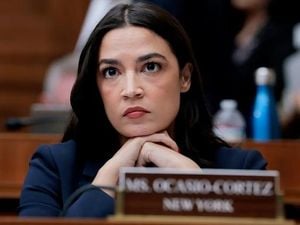On August 23, 2025, a Los Angeles judge handed down a court order that brings a dramatic shift to the very public saga between Halle Bailey and her ex-partner, rapper and YouTuber DDG, over their 19-month-old son, Halo. The ruling, which prohibits both Bailey and DDG from posting any photographs, images, or information about Halo on social media or anywhere on the Internet, marks a decisive intervention in a case that has played out under the glare of both the courtroom and the spotlight of celebrity culture.
According to court documents obtained by People and reported by several outlets, the order is sweeping: not only are Bailey and DDG barred from sharing anything about their son online, but anyone within their immediate circles is also forbidden from posting, uploading, or disseminating any details, images, or videos of Halo. The judge emphasized that the protection of Halo’s privacy is paramount, stating, “Both parties must refrain from posting, uploading, or disseminating on the internet or social media any material regarding the minor child.” This directive extends to preventing others from acting on their behalf to share such content, a clear sign of the court’s intent to keep the toddler’s life out of the public eye.
This ruling is more than a simple social media ban; it’s the latest development in a contentious and highly publicized custody dispute. The court also updated visitation rights, granting DDG, whose real name is Darryl Dwayne Granberry Jr., the ability to see Halo every Wednesday and Saturday from 9 a.m. to 6 p.m., as well as every other Sunday during the same hours. However, these visits come with a significant caveat: they must be professionally monitored. The monitor’s role isn’t just to oversee the father-son interactions, but also to ensure strict adherence to the court’s social media restrictions. As the documents explain, “The professional monitor is to be advised and instructed that a primary purpose of the monitoring requirement is to ensure compliance with the Court’s orders regarding social media posting, dissemination of information, and the like.”
For many fans who delighted in the glimpses of Baby Halo on Instagram and other platforms, this ruling is a bittersweet moment. The adorable snapshots and family moments that once peppered Bailey’s social feeds are now a thing of the past. But for the court, the decision is about something much bigger: shielding a young child from the sometimes toxic intersection of celebrity, social media, and personal disputes.
The roots of this court order stretch back through a tumultuous summer of legal wrangling. In June 2025, DDG filed for an emergency hearing, attempting to stop Bailey from taking Halo to Italy while she was scheduled to shoot a film. In his plea, DDG accused Bailey of domestic abuse and argued that her struggles with postpartum depression posed “an imminent emotional and psychological risk to the minor child based on repeated, documented threats of self-harm.” The judge, however, was not persuaded by these arguments and denied the request, allowing Bailey to travel with Halo as planned.
This emergency hearing was not the first time the couple’s private struggles spilled into the public sphere. Just a month earlier, in May 2025, Bailey was granted a temporary restraining order against DDG after providing the court with evidence of physical abuse. In her declaration, Bailey described a pattern of both verbal and physical mistreatment, including incidents where DDG called her derogatory names in front of their son. She also accused him of using his considerable social media following to incite online hostility against her. “Whenever he wishes to cause upset, he starts badmouthing me to his several millions of fans,” Bailey wrote in her statement to the court. “He claims I am withholding our son and that I am with other men. As a result, I then receive threats and hate on social media. He seems to try to set up drama for his fans. He goes ‘live’ ranting about me and alleges that I am keeping Halo from him. This is false. I have requested a set schedule, which he refuses.”
The restraining order, which remains in effect, requires DDG to stay at least 100 yards away from both Bailey and Halo. This legal boundary underscores the significant strain and mistrust that has come to define their co-parenting relationship. According to The South African, Bailey made it clear in her court filings: “I cannot allow this abuse any longer.” Her words highlight the emotional toll that the ongoing conflict—and its very public nature—has taken on her and, potentially, on young Halo.
For his part, DDG has maintained that his actions are motivated by concern for his son’s well-being. Yet the court’s repeated refusals to grant his emergency requests, alongside the imposition of supervised visitation and the social media gag order, suggest that the judge’s sympathies lie elsewhere. The professional monitor’s dual role—ensuring both the child’s safety and the enforcement of the social media ban—reflects a judicial recognition of the unique pressures and risks that come with raising a child in the digital age, especially when both parents are public figures.
This case has caught the attention of legal experts and parents alike, raising thorny questions about the boundaries of parental rights, the responsibilities of celebrity, and the role of the courts in protecting children’s privacy. In an era where the line between private life and public persona is increasingly blurred, the court’s decision sets a precedent: the welfare of the child must come first, even if it means disappointing legions of fans and curtailing the digital storytelling that has become second nature for so many modern families.
The story of Halle Bailey, DDG, and their son Halo is a cautionary tale about the costs of living—and parenting—under the microscope. As the dust settles on this latest chapter, both parents are now legally compelled to keep their son’s life offline, at least for the foreseeable future. For now, Baby Halo’s world will be a little more private, and perhaps, a little more peaceful. The court’s ruling may not heal all wounds or resolve every dispute, but it draws a clear line in the sand about what matters most when the interests of a child are at stake.




